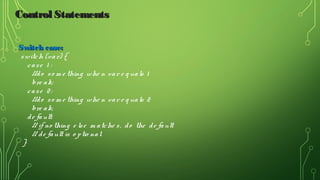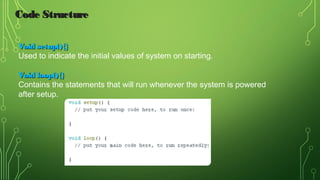Arduino Platform with C programming.
- 1. THE ARDUINO PLATFORM AND C PROGRAMMING PRESENTED BYPRESENTED BY GOVIND JHAGOVIND JHA
- 2. What is Arduino? A microcontroller board, contains on-board power supply, USB port to communicate with PC, and an Atmel microcontroller chip. It simplify the process of creating any control system by providing the standard board that can be programmed and connected to the system without the need to any sophisticated PCB design and implementation. It is an open source hardware, any one can get the details of its design and modify it or make his own one himself.
- 3. Arduino Development BoardArduino Development Board • Eight bit microcontroller – brain of the boardEight bit microcontroller – brain of the board • USB Port – to communicate with theUSB Port – to communicate with the desktop/laptopdesktop/laptop • USB controller chip – manages USB transferredUSB controller chip – manages USB transferred datadata • IO pins – board’s connection to the outside worldIO pins – board’s connection to the outside world • Quartz oscillator – board’s time keeperQuartz oscillator – board’s time keeper • Reset button – taking the board back to its initialReset button – taking the board back to its initial statestate • External power jack – power from dedicatedExternal power jack – power from dedicated sourcesource Co-axial jack, but USB can also be used.Co-axial jack, but USB can also be used.
- 4. Arduino UNO:Arduino UNO: Digital output ~: PWM. 0,1: Serial port. In circuit Serial programming Atmel MicroController Analog input.Power Supply USB port Power input
- 5. Input/output Pins (I/OPins)Input/output Pins (I/OPins) • Top and bottom rows of the boardTop and bottom rows of the board • Holes in the board which we can stick wires inHoles in the board which we can stick wires in • Holes are connected to the chips through traces on-boardHoles are connected to the chips through traces on-board • 14 Digital I/O pins on top [0-13]14 Digital I/O pins on top [0-13] • Highs – 5 voltsHighs – 5 volts Lows – 0 voltsLows – 0 volts Max Current - 40 mAMax Current - 40 mA • 6 Analog input pins on the bottom [A0 – A5]6 Analog input pins on the bottom [A0 – A5] • Power output pins on the bottom [ 5v , 3.3 v ]Power output pins on the bottom [ 5v , 3.3 v ] • Reset pin to reset the board to initial state.Reset pin to reset the board to initial state.
- 6. MicrocontrollersMicrocontrollers • Two microcontrollers on the boardTwo microcontrollers on the board • Main ATmega328 – 8 bit microcontrollerMain ATmega328 – 8 bit microcontroller • User programmable, runs user-written application codeUser programmable, runs user-written application code Carries firmware, like bootloaderCarries firmware, like bootloader • ATmega16U2ATmega16U2 • Handles the communication with the USB interface, notHandles the communication with the USB interface, not directly accessibledirectly accessible
- 7. Storage and MemoryStorage and Memory •Non-volatile flash memory for storageNon-volatile flash memory for storage •32 kilobytes in size32 kilobytes in size •Static Random Access Memory (SRAM) for memoryStatic Random Access Memory (SRAM) for memory (volatile)(volatile) •3 kilobytes in size3 kilobytes in size
- 8. ClockClock • 16 MHz clock speed ~ 16 million operations per16 MHz clock speed ~ 16 million operations per secondsecond • Helps synchronize all components togetherHelps synchronize all components together • Keeping track of occurrence of eventsKeeping track of occurrence of events
- 9. Programming FirmwareProgramming Firmware • The ISCP headers can be used to program theThe ISCP headers can be used to program the firmware on the boardfirmware on the board • ICSP1 for the main ATmega328 microcontrollerICSP1 for the main ATmega328 microcontroller • ICSP2 for the ATmega16U2 microcontrollerICSP2 for the ATmega16U2 microcontroller • Special equipment are required in order to re-Special equipment are required in order to re- program the firmware through these headersprogram the firmware through these headers
- 10. Software EnvironmentSoftware Environment • Arduino IDE – Integrated Development EnvironmentArduino IDE – Integrated Development Environment • Can be programmed using other IDEs too, like EclipseCan be programmed using other IDEs too, like Eclipse • Arduino IDE is more versatileArduino IDE is more versatile • Needs no special drivers or additional componentsNeeds no special drivers or additional components • Available for Windows, Linux and MacAvailable for Windows, Linux and Mac • Cross compiler – compiles for a different target platform than the one beingCross compiler – compiles for a different target platform than the one being programmed onprogrammed on
- 11. IDE – Software Tool forIDE – Software Tool for ProgrammingProgramming • File operations and other general options on topFile operations and other general options on top • Buttons for most commonly used options (Verify, Upload,Buttons for most commonly used options (Verify, Upload, etc.)etc.) • Main window – Text editor for writing codeMain window – Text editor for writing code • Message area – for messages to the programmerMessage area – for messages to the programmer
- 12. Options ButtonsOptions Buttons Buttons on the top have the most common ,useful operationsButtons on the top have the most common ,useful operations Verify – compiles the code and checks for errorsVerify – compiles the code and checks for errors Uploads – compiles the code, uploads it to the board. Works only ifUploads – compiles the code, uploads it to the board. Works only if the board is connectedthe board is connected New – creates a new sketch, a new programNew – creates a new sketch, a new program Open – opens an existing sketchOpen – opens an existing sketch Save – saves the current sketch in the directory of your choiceSave – saves the current sketch in the directory of your choice Serial Monitor – opens window to communicate with the boardSerial Monitor – opens window to communicate with the board
- 13. Arduino ShieldsArduino Shields • The prominent reason that Arduino got so popularThe prominent reason that Arduino got so popular • Additional hardware to do particular, complex tasksAdditional hardware to do particular, complex tasks • Form of separate boardsForm of separate boards • Pre-wired pins that stick into holes in ArduinoPre-wired pins that stick into holes in Arduino • Stack on top of the Arduino to make connectionsStack on top of the Arduino to make connections • Pre-written functions for operations of these boardsPre-written functions for operations of these boards • Open-source designs in most of the cases, third partyOpen-source designs in most of the cases, third party •
- 14. • IntegerInteger: used with integer variables with value between 2147483647 and -2147483647. Ex: int x=1200; • CharacterCharacter: used with single character, represent value from -127 to 128. Ex. char c=‘r’; • LongLong: Long variables are extended size variables for number storage, and store 32 bits (4 bytes), from -2,147,483,648 to 2,147,483,647. Ex. long u=199203; • Floating-point:Floating-point: Numbers can be as large as 3.4028235E+38 and as low as -3.4028235E+38. They are stored as 32 bits (4 bytes) of information. Ex. float num=1.291; [The same as doubledouble type] Data Types and OperatorsData Types and Operators
- 15. Statement represents a command, it ends with ;; Ex: int x; x=13; Operators are symbols that used to indicate a specific function: - Math operators: [+,-,* ,/,%,^+,-,* ,/,%,^] - Logic operators: [==, !=, &&, ||==, !=, &&, ||] - Comparison operators: [==, >, <, !=, <=, >===, >, <, !=, <=, >=] Syntax: ;; Semicolon, {}{} curly braces, ////single line comment, /*/* Multi-line co m m e nts * /* / Statement and OperatorsStatement and Operators
- 16. Compound Operators:Compound Operators: ++ (increment) -- (decrement) += (compound addition) -= (compound subtraction) *= (compound multiplication) /= (compound division) Statement and OperatorsStatement and Operators
- 17. If Conditioning:If Conditioning: if(co nditio n) { state m e nts-1 ; … State m e nt-N; } else if(co nditio n2 ) { State m e nts; } Else{state m e nts ;} Control StatementsControl Statements
- 18. Switch case:Switch case: switch (var) { case 1 : //do so m e thing whe n var e q uals 1 bre ak; case 2: //do so m e thing whe n var e q uals 2 bre ak; de fault: // if no thing e lse m atche s, do the de fault // de fault is o ptio nal } Control StatementsControl Statements
- 19. Do… while:Do… while: do { Statements; } while(condition); // the statements are run at least once. While:While: While(condition) {statements;} forfor for (int i=0; i <= val; i++){ statements; } Loop StatementsLoop Statements
- 20. Void setup(){}Void setup(){} Used to indicate the initial values of system on starting. Void loop(){}Void loop(){} Contains the statements that will run whenever the system is powered after setup. Code StructureCode Structure
- 21. Arduino Tool chainArduino Tool chain • Steps taken post code authoringSteps taken post code authoring • Source code(sketch) is compiled to an executableSource code(sketch) is compiled to an executable formatformat • Executable file is linked with libraries and interpretedExecutable file is linked with libraries and interpreted into a hex fileinto a hex file • Hex file is uploaded to boardHex file is uploaded to board • Starts executing right awayStarts executing right away
- 22. Cross CompilationCross Compilation • Compile on one machine, but the target is another machine.Compile on one machine, but the target is another machine. E.g.: compiling it on an Intel processor, compiling it for anE.g.: compiling it on an Intel processor, compiling it for an AVR processorAVR processor • avr-gcc – C compiler for AVR targets, gives a *.o fileavr-gcc – C compiler for AVR targets, gives a *.o file • avr-lnk – links library object files, results in a *.elf fileavr-lnk – links library object files, results in a *.elf file • avr-objcopy – change the *.elf file into Arduino compatible *.hexavr-objcopy – change the *.elf file into Arduino compatible *.hex filefile
- 23. Running IDE on WindowsRunning IDE on Windows • Emacs or NotePad++ text editorEmacs or NotePad++ text editor • Gcc C compilerGcc C compiler • The debugger, gdbThe debugger, gdb • IDE provides one-stop solutionIDE provides one-stop solution
- 24. BlinkLEDExampleBlinkLEDExample • Pin 13 is represented by numeral 13Pin 13 is represented by numeral 13 • digitalWrite() writes voltage values todigitalWrite() writes voltage values to pinspins • delay() sets delays in millisecondsdelay() sets delays in milliseconds • HIGH – 5vHIGH – 5v LOW – 0vLOW – 0v
- 25. THE ENDTHE ENDTHANK YOUTHANK YOU
Editor's Notes
- #10: In circuit serial programmer




![Input/output Pins (I/OPins)Input/output Pins (I/OPins)
• Top and bottom rows of the boardTop and bottom rows of the board
• Holes in the board which we can stick wires inHoles in the board which we can stick wires in
• Holes are connected to the chips through traces on-boardHoles are connected to the chips through traces on-board
• 14 Digital I/O pins on top [0-13]14 Digital I/O pins on top [0-13]
• Highs – 5 voltsHighs – 5 volts Lows – 0 voltsLows – 0 volts
Max Current - 40 mAMax Current - 40 mA
• 6 Analog input pins on the bottom [A0 – A5]6 Analog input pins on the bottom [A0 – A5]
• Power output pins on the bottom [ 5v , 3.3 v ]Power output pins on the bottom [ 5v , 3.3 v ]
• Reset pin to reset the board to initial state.Reset pin to reset the board to initial state.](https://image.slidesharecdn.com/wintertraningarduinoppt-170602104008/85/Arduino-Platform-with-C-programming-5-320.jpg)

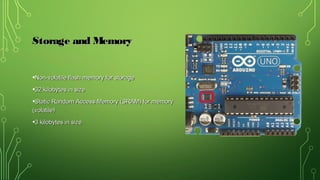


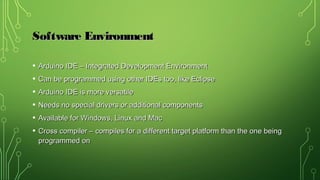

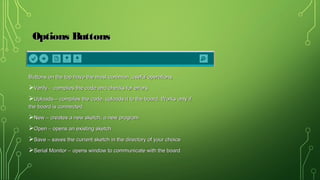

![• IntegerInteger: used with integer variables with value between
2147483647 and -2147483647.
Ex: int x=1200;
• CharacterCharacter: used with single character, represent value from -127 to
128.
Ex. char c=‘r’;
• LongLong: Long variables are extended size variables for number
storage, and store 32 bits (4 bytes), from -2,147,483,648 to
2,147,483,647.
Ex. long u=199203;
• Floating-point:Floating-point: Numbers can be as large as 3.4028235E+38 and
as low as -3.4028235E+38. They are stored as 32 bits (4 bytes) of
information.
Ex. float num=1.291; [The same as doubledouble type]
Data Types and OperatorsData Types and Operators](https://image.slidesharecdn.com/wintertraningarduinoppt-170602104008/85/Arduino-Platform-with-C-programming-14-320.jpg)
![Statement represents a command, it ends with ;;
Ex:
int x;
x=13;
Operators are symbols that used to indicate a specific function:
- Math operators: [+,-,* ,/,%,^+,-,* ,/,%,^]
- Logic operators: [==, !=, &&, ||==, !=, &&, ||]
- Comparison operators: [==, >, <, !=, <=, >===, >, <, !=, <=, >=]
Syntax:
;; Semicolon, {}{} curly braces, ////single line comment, /*/* Multi-line
co m m e nts * /* /
Statement and OperatorsStatement and Operators](https://image.slidesharecdn.com/wintertraningarduinoppt-170602104008/85/Arduino-Platform-with-C-programming-15-320.jpg)


